There are many reasons that may explain why some people choose to seek help through counselling and others do not. There are also many ways to describe how well people engage with counselling services once help has been sought. Common reasons cited in contemporary studies include a person’s capacity to address their problems, the counsellor’s ability to identify their problem, the client’s willingness to participate in homework, co-morbid health conditions and how well people relate to their therapist
Introduction
There are many reasons that may explain why some people choose to seek help through counselling and others do not. There are also many ways to describe how well people engage with counselling services once help has been sought. Common reasons cited in contemporary studies include a person’s capacity to address their problems, the counsellor’s ability to identify their problem, the client’s willingness to participate in homework, co-morbid health conditions and how well people relate to their therapist.
However, the level of a person’s engagement with counselling can be difficult to measure. Researchers often use attendance, or the number of sessions a person attends, as a proxy for measuring a person’s engagement with the counselling process.
Studies show that a large proportion of counselling clients only attend a single session and therefore recent research suggests that a client’s attendance at a service is not necessarily a reliable indicator of their commitment. Rather, the number of sessions a person attends is influenced by their level of distress (less distressed clients attend fewer sessions), the resolution of the problem, or a range of other reasons and barriers.
Relationships Australia’s August online survey sought further evidence to understand this issue by asking visitors to our website a few questions about the reasons that would influence them to attend, or not attend, a counselling service.
Previous research finds that…
- The effect of the number of counselling sessions attended on a range of relationship outcomes is mixed.
- Howard et al. (1986) found that number of counselling sessions attended affected outcomes for clients with an average of 30% of clients showing clinical improvement after 2 sessions, 53% after 8 sessions, and 74% after 26 sessions. However, a number of more recent studies have found that the number and length of couple therapy sessions did not affect outcomes for these clients.
- In a study conducted by Relationships Australia, 80% of clients attended 3 or fewer sessions.
Survey Results Analysis
More than 2010 people responded to the Relationships Australia online survey in September. Almost four-fifths of survey respondents (78%) identified as female.
As was the case for last month’s survey, more females than males responded in every age group (figure 1). Almost ninety per cent of survey respondents were aged between 20‑59 years, with the highest number of responses collected for women aged between 30-39 years (inclusive).
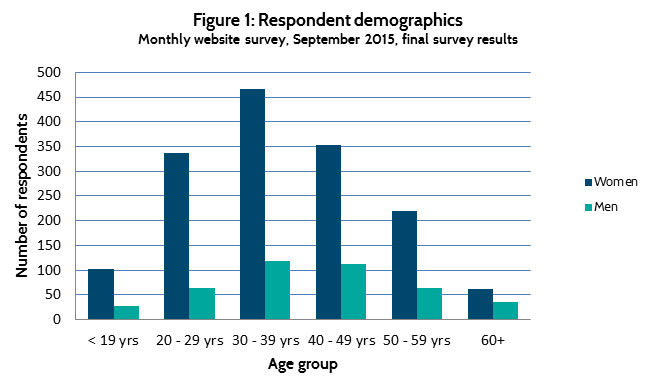
The demographic profile of survey respondents remains consistent with our experience of the people that would be accessing the Relationships Australia website.
Almost 40 per cent (39%) of women and more than 45 per cent of men (46%) reported that they came to the Relationships Australia website looking for a counselling or mediation service (figure 2). Men were more likely than women to report that they were looking for information about relationships (26% when compared to 22%), while just over 20% of survey respondents came to the website for ‘other’ reasons.
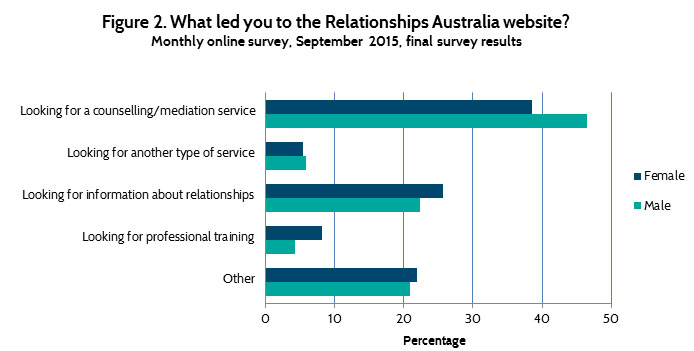
More than half of survey respondents indicated that they had previously attended counselling (women 53% ; men 46%). A further 20 per cent of female respondents and 23 per cent of male respondents indicate that they had previously considered counselling but had never attended. Almost twenty per cent (18%) of men and one-tenth (12%) of women reported that they had never considered counselling (figure 3).
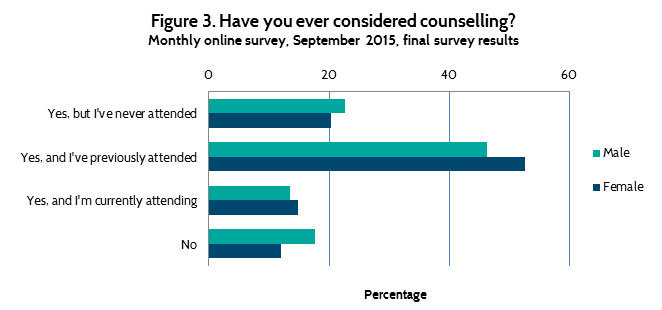
Over half of survey respondents indicated that counselling was their own idea (figure 4), with women more likely than men to report this reason (59% compared with 49%). The next most commonly cited reasons for thinking about counselling were advice from friends, relatives or colleagues (women 15%; men 14%), or service providers (women 10%; men 8%). Fifteen per cent of men compared with four per cent of women indicated it was their partner’s idea.
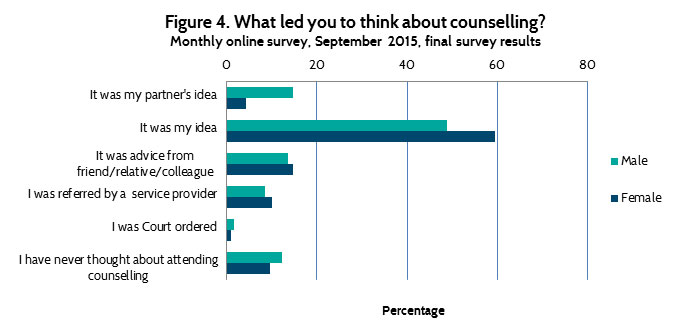
Not surprisingly, the most common reason given by respondents to Relationships Australia’s monthly online survey when asked about problems that would lead them to counselling was relationship issues (41%). Women were more likely than men to report that family violence, family issues or their own strong emotions were more likely to lead them to counselling, while men were more likely to report relationship issues, seeking help with communication skills and other reasons as more likely to lead them to counselling (figure 5).
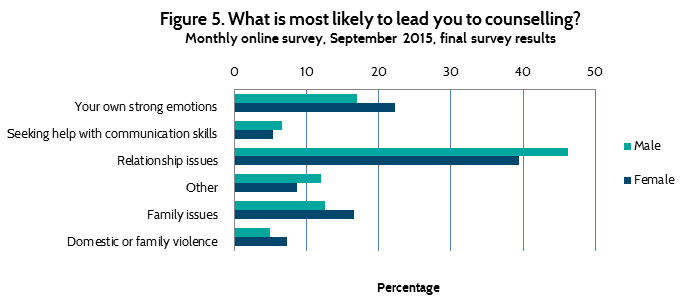
Around three-quarters of survey respondents (women 77%; men 74%) indicated that they thought the number of counselling sessions needed to help someone depended on the situation (figure 6). Very few respondents thought that counselling didn’t help people.
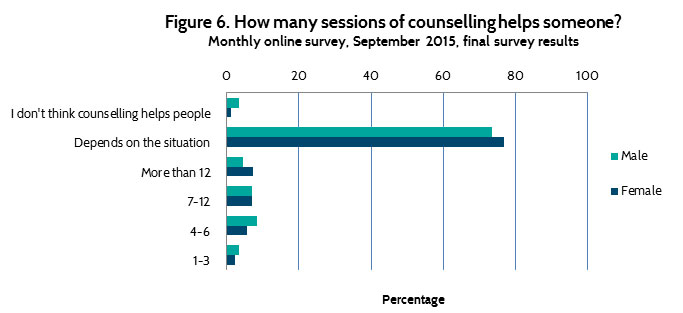
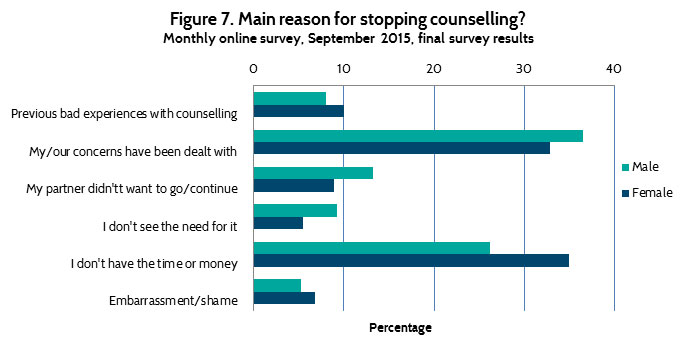
Figure 7 shows the main reasons men responding to the monthly online survey reported for stopping counselling were time or money (26%) or that their concerns had been dealt with (37%). Women also reported the same main reasons; however, they were more likely than men to report that a lack of time or money would stop them continuing with counselling (35%) and less likely to report that their concerns had been dealt with as a reason for stopping counselling (33%).
References
Holdsworth, E, Bowen, E, Brown, S and Howat, D, 2014, Client engagement in psychotherapeutic treatment and associations with client characteristics, therapist characteristics, and treatment factors, Clinical Psychology Review, Volume 34 (5)
Owen, J, Smith, A and Rodolfa, E, 2009, Clients’ Expected Number of Counseling Sessions, Treatment Effectiveness, and Termination Status: Using Empirical Evidence to Inform Session Limit Policies, Journal of College Student Psychotherapy, Volume 23(2):118-134
Petch, J, Lee, J, Huntingdon, B, and Murray, J, 2014, Couple Counselling Outcomes in an Australian Not for Profit: Evidence for the Effectiveness of Couple Counselling Conducted Within Routine Practice, Australian and New Zealand Journal of Family Therapy, Volume 35:445–461
Shadish, W. R., & Baldwin, S. A. (2005). Effects of behavioral marital therapy: A meta-analysis of randomized controlled trials. Journal of Consulting and Clinical Psychology, 73, 6-14. doi: 10.1037/0022-006X.73.1.6
